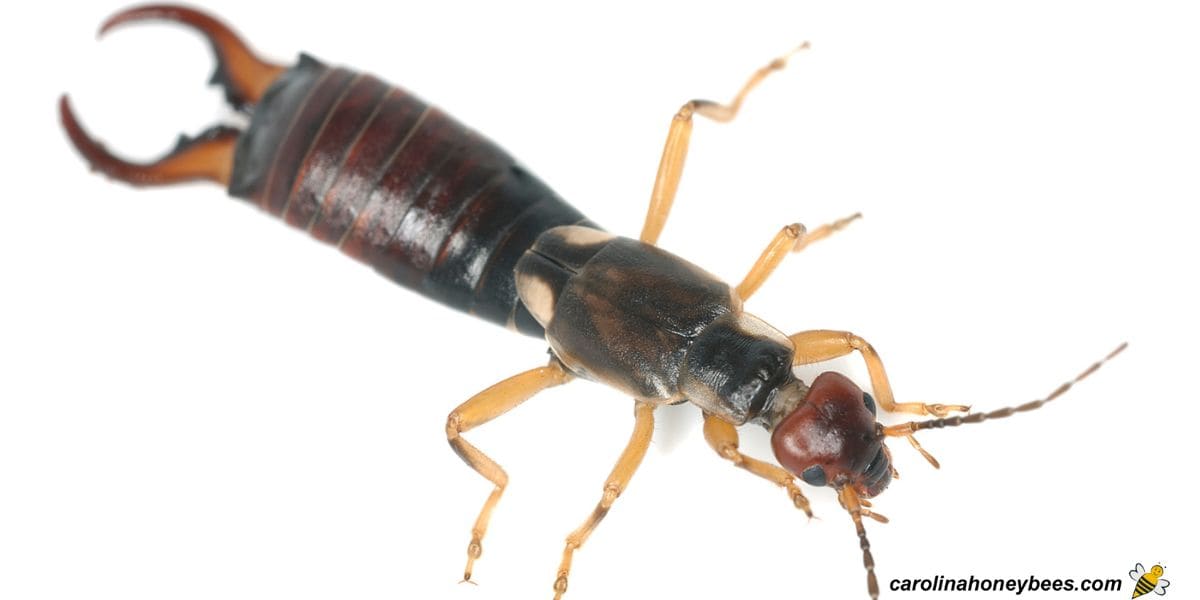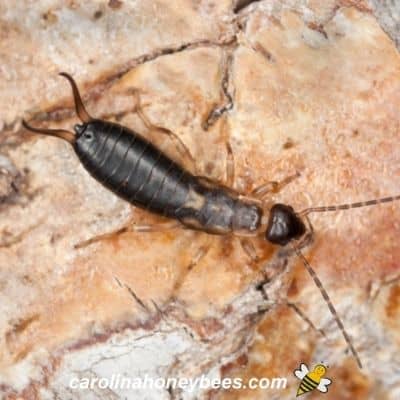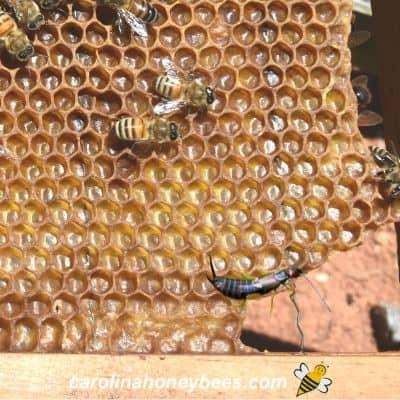Earwigs
A cautious beekeeper is always concerned about any threat to the hive. Imagine the surprise the first-time earwigs are found inside your beehive! Yikes – they look weird. In fact, their strange features are rather alarming. What is this bug with pinchers on its butt? Do earwigs hurt bees? Likely not. But, an important part of beekeeper education is learning which things are real problems and which are just a nuisance.

We expect hives to have some honey bee pests. But, as a beekeeper, I dislike seeing unauthorized guests in my hives. Some cause big problems but others are only a minor aggravation in most cases.
Are Earwigs Bad for Bees?
There are actually many types of life inside your beehives. Most survive in the hive ecosystem going about their life cycle with no harm to the honey bees.
Of course, some microscopic organisms do kill bees or sicken the honey bee colony. Nosema disease, bacteria that causes foul brood and many viruses represent a true danger to our bees.
It is a common occurrence to find small insects taking advantage of a dry place to live. They are most commonly found between the inner and outer cover or on the bottom board.
What are Earwigs?
Earwigs are members of the order “dermaptera”. More than 20 different species live in the US. They are omnivorous scavengers that live on plant and insect material.
The big pinchers on the end are used for hunting and to catch prey. Normally, they do not use them on humans. You are unlikely to be pinched, stung or bit by them.
These insects are actually considered beneficial in some ways. Even though they can damage plant material, they eat aphids, mites and other insects that cause damage in the garden.

Living for about a year, they feed on all kinds of decaying organic material. They do have wings and some types can fly. But, they primarily crawl to get around and can move rather fast for their size.
Perhaps in part due to their unusual appearance, earwigs or pincher bugs are the subject of an “old wives tale”.
It was rumored that they would crawl into the human ear and lay eggs in your brain. We must wonder who first came up with that nightmare. But then it is similar to our says such as “cats pajamas” or “bees knees.”
Are They Beneficial to the Colony?
In most cases, a few earwigs in the beehive is not cause for concern. They are considered more of a nuisance than a real problem. This does not mean however that they are welcomed visitors in our beehives.
In spite of some reports of them supposedly eating varroa mites, there no solid evidence that this is a beneficial asset to the colony.
Perhaps, if the earwigs are on the bottom board and a mite falls – they take advantage of the snack.
However, most of the varroa mites are not on the bottom board. So don’t think that having a few of these pests in your hive will solve your varroa mite problem.
There have also been reports of earwigs breaking open the caps of stored honey. The resulting trash, feces etc allowed to enter the cell may ruin the honey.
Another concern, is the slight possibility that they may carry disease that can pass throughout the colony. But, there is no hard scientific evidence to back any of these claims up.

How to Get Rid of Earwigs Without Harming Bees
As with many minor pests of honey bees, the best way to get rid of earwigs in your hives is to keep strong colonies. Worker bees do a great job of patrolling the interior of the hive and giving free loaders the boot.
Avoid giving your bees more area inside the hive than they can patrol. That’s just good basic hive management anyway.
They will happily chase and remove unwanted visitors. In beekeeping, we can help our girls by managing our colonies in the best way.
This post may contain affiliate links. As an Amazon Associate, I earn from qualifying purchases. Please read my disclosure.
When you see these earwigs in your beehive, don’t miss the opportunity to squish them with your hive tool. That’s one less thing for your bees to have to deal with. But, there is no reason to upset the colony trying to hunt them down either.
In addition, these pests can often be found in stored honeycomb supers. I have personally seen this in my open air storage shed.
Hanging frames of comb are stored exposed to light and air to protect them from wax moths.
It is common to find numerous earwigs living in this comb. While they don’t seem to harm the comb, we do not like seeing them. Frustrating as this may be, the comb does not seem to suffer any ill effects.
Beekeepers who use PDB to store supers with comb have the added plus of it keeping earwigs out too. But, not everyone wants to use PDB.
As a slightly better solution – purchase a peppermint based earwig repellent to spray near your equipment to repel these pests.
Personally, I would not spray it on the comb or woodenware. You can bump your frames of comb on the ground before storing to dislodge any unwanted residents in the honeycomb.
FAQs
In general, earwigs do not pose any threat to honey bees or equipment. Control is not normally necessary.
Birds, toads and other insect predators will prey on earwigs.
Earwigs have a life span of about one year.
Final Thoughts
Our bee colonies have to face many obstacles in daily life. There are many predators looking for a nice juicy meal – there are even some birds that eat bees.
But, it is really not necessary to try to catch them in the manner we place hive beetle traps inside our hives. They are all just trying to survive.
Earwigs do not pose a serious threat to most honey bee colonies. While there is no need to declare full out war on them, it’s okay to remove any from the hive when you are able.
.


